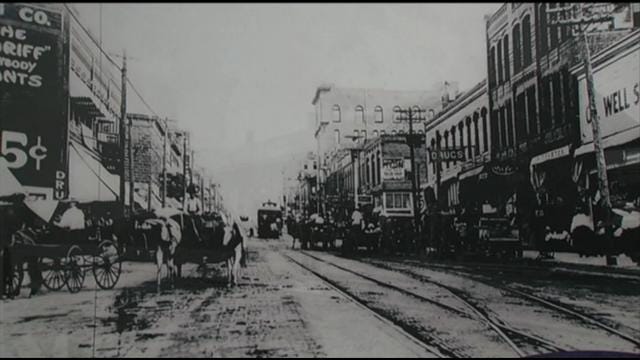6 On The Move: The History Of The Brady District, Tulsa's First Neighborhood
A Century ago, the Brady District was a neighborhood of warehouses and steam engines, but as our new media center proves, it's always been a place filled with big plans and high hopes.Wednesday, January 23rd 2013, 10:29 pm
We're settling in here in our new home in the Brady Arts District. It puts us in the city's original neighborhood.
Just a hundred years ago, this was still a neighborhood of cattle drives and steam engines, but as our new Griffin Communications Media Center proves, it's always been a place filled with big plans and high hopes.
For 20 years, Spaghetti Warehouse has served heaping bowls of Italia, amid the comforting clutter of old signs and flashing neon in a rehabbed 1917 grocery warehouse at North Detroit and Brady. But this isn't where they wanted to be.
The first warehouse the company had its eyes on was in what's now called the East Village at Third and Greenwood.
It was burned to the ground by an arsonist on a Saturday night in August 1991, just as Spaghetti Warehouse was beginning its renovation.
So, the restaurant found a home in another old warehouse, in the Brady District: a grimy, rundown, forgotten mash-up of abandoned storefronts and forgotten flophouses.
In doing so, they became the first big restaurant pioneer in the Brady's rebirth. They've waited two decades for everyone else to catch up.
Brady Reborn: Tulsa's Downtown Arts District Revitalized
"Any time there's an event at the BOK, the PAC, we also have the Brady Theatre and Cain's, anytime there's a big event we do see the traffic from it," said General Manager Kristen Ireton.
Knowing the Spaghetti Warehouse Company does a good amount of research before investing in a new place, Bradley Garcia thus felt emboldened, on the last day of 1998, to buy the old Gypsy Oil building just around the corner.
Today, his friends call him visionary, but that wasn't the case 14 years ago.
"Crazy, crazy for going to this blighted area of Tulsa," Garcia said.
He gave up his share of what was then the largest hair salon in the city, on the south side, for a smaller place he designed in J. Paul Getty's old building, along with a coffeehouse where he could share his love of a bohemian lifestyle.
1/23/2013 Related Story: 6 On The Move: The Norwegian Ghost That Haunts Our New Neighbor
"I couldn't get a bank to touch financing on this property. I had to go to Miami, Florida, to find an LLC that would finance this property and they said 'You've got a diamond in the rough,' and I said 'Yes, I do, unfortunately no one in Tulsa has seen that,'" Garcia said.
At least not in a long time. But this neighborhood was Tulsa's original. It's where the city began with tents, cattle grazing on the prairie, and cowboys traveling muddy, rutted trails.
"It was a tent city, but it became where all the rooming houses, hotels, all the action was, up and down Main Street," said City Preservation Planner Amanda Decourt.
It took the arrival of the railroads before Main Street became the main street.
The Frisco and the Katy lines opened the little settlement to the rest of the world.
"It was a dusty, grimy, hardscrabble railroad town," Decourt said.
Until black gold shot to the sky in Glenpool and Red Fork, then Tulsa boomed as the supplier to the oil fields, and it was all centered along Main Street.
"Everyone wanted to be close to the railroad, that's why the Brady Hotel was built one block away from the railroad, so people coming in and out on the train could walk to the hotel and stay," said architectural historian Cathy Ambler.
In 1903, thirteen years after he'd stepped off a train in Tulsa, Tate Brady built his hotel at Main and Archer. It was the first in town with indoor baths.
By then, Brady had made his fortune with the town's first variety store. The garage he built would become Cain's Ballroom.
He was one of the signers of the charter that made Tulsa a city, and a noted Ku Klux Klansman.
By the time he killed himself with a bullet to the head, despondent over the death of a son, the neighborhood that would take his name was filling up with warehouses, factories and storage yards for the oil fields.
"We're sandwiched in between railroads and the activity that's going on. You can imagine trains coming and going all the time, people getting on, getting off, walking to work, walking to manufacturing plants," Ambler said.
The neighborhood kept growing with manufacturing, pipe yards, repair shops and warehouses, all tied together by the soot and cinders of the steam engines.
You can still see remnants of the rights-of-way, forgotten now in the weeds, and where the spurs that crisscrossed the neighborhood would bring trains right through the buildings.
Then trucking brought even bigger warehouses, and the boom went on, until 50 years after it began, when things began to slow, and Tulsa turned its back on the place where it began.
"I call it the Rip Van Winkle stage of the Brady, was kind of between the 1960s and the 1980s, when it went through its sleep period of quiet decline—I think that's the best way to say it," said Ambler.
In recent years, developers like David Sharp have quietly worked to save the building stock.
And the George Kaiser Family Foundation has not only made splashy investments like the Guthrie Green, but worked behind the scenes to guide the neighborhood's comeback in a tasteful way.
"Keeping the local businesses, keeping the artists at the center of it," said Stanton Doyle, of the George Kaiser Family Foundation.
It wasn't too long ago that the Katy Railroad tracks ran straight through what is now the parking lot of our new Griffin Communications Media Center.
The era of steam trains and the era of high-definition broadcast television is linked by less than a century, and a great American city tied together by pioneers on either end, the new respecting the old and the patience and imagination that builds places that last.
"Not in my wildest dreams could I have imagined what has gone on and has come in down here," Garcia said.
More Like This
January 23rd, 2013
September 29th, 2024
September 17th, 2024
Top Headlines
November 16th, 2024
November 16th, 2024
November 16th, 2024
November 16th, 2024














